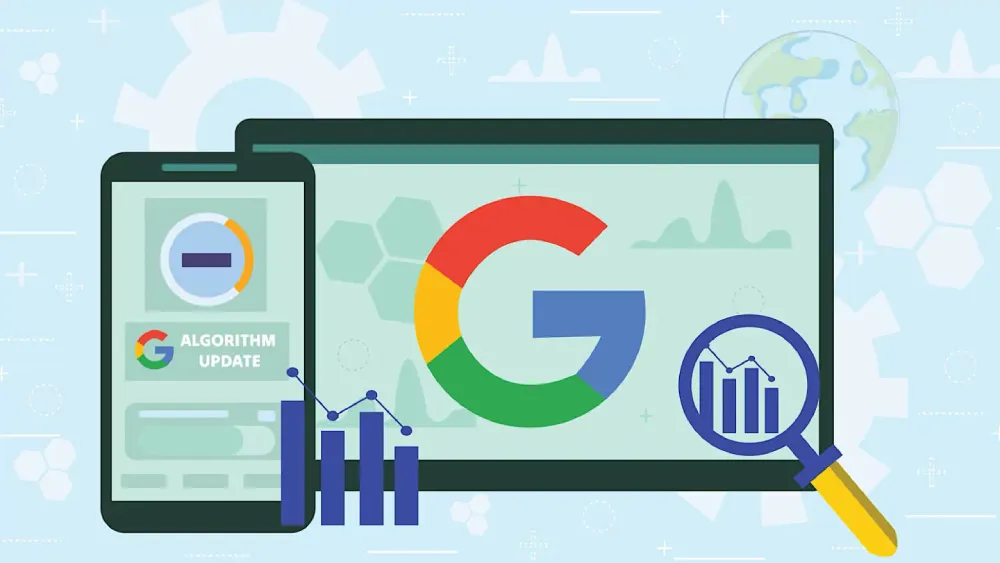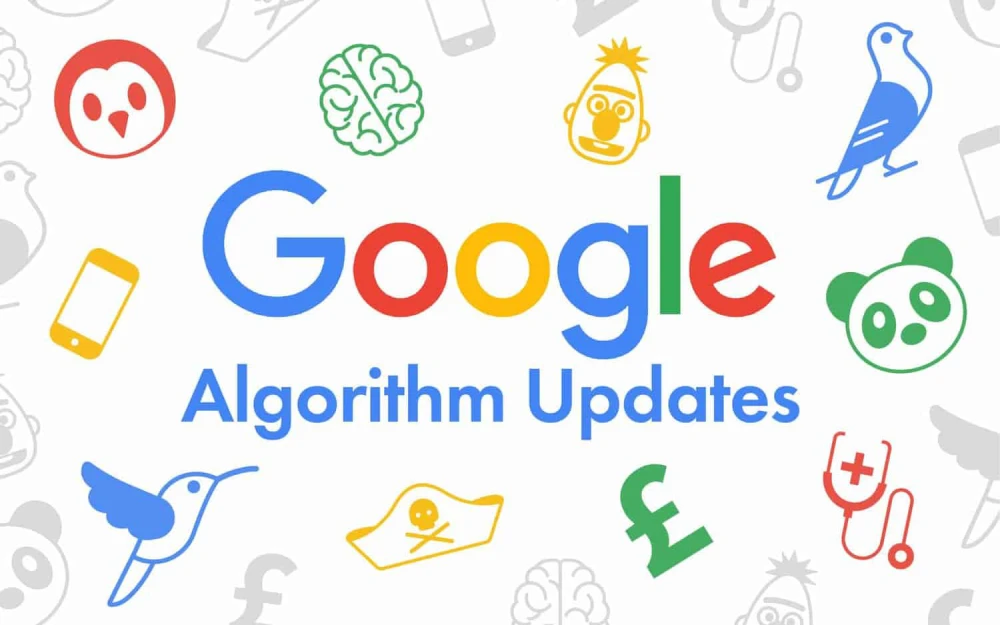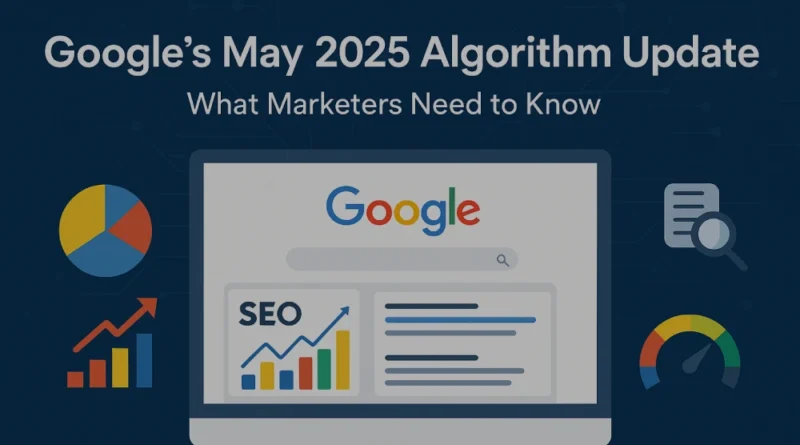Google’s May 2025 Algorithm Update: What Marketers Need to Know
The update of Google algorithms in May 2025 has caused certain stirrings throughout the SEO and digital marketing, as a new set of regulations is targeting a change in the approach to quality, user experience, and authenticity. In a more competitive digital world, it is important as marketers, in order to remain visible, to stay ahead of these changes, and thus, increase traffic. Being as inclusive as possible, this guide will cover the essential points of this update, share the tactics of adaptation relevant in real life, and offer special advice, such as local information within the context of Indian companies, to assist you in the process of synchronizing your parameters with the requirements of Google.
Understanding the May 2025 Algorithm Update
According to Search Engine Roundtable, the May 2025 is a fundamental algorithm change that underscores the company Google concentrates on rewarding superior user-friendly content and penalizes undesired SEO tactics. Compared to the core update that will follow in June 2025 and is scheduled to roll-out on June 30, 2025, and be fully implemented in three weeks, the May one was not a full-fledged core update, but an optimization of the current signals. The most significant areas of influence are the authenticity in the content, the technical performance, and increased checks of the backlink profiles.
Here are the primary changes marketers need to know:
- 1. Enhanced E-E-A-T Signals: Google still gives preference to those contents that have proven (or at least show) Experience, Expertise, Authoritativeness, and Trustworthiness, especially in YMYL areas (Your Money, Your Life) such as finance, medical and pharmaceutical information, and legal information. Sites that had explicit author-crediting and sourcing, were ranked higher.
- 2. Improved User Experience A Metrics: Core Web Vitals, including Largest Contentful Paint (LCP), First Input Delay (FID), and Cumulative Layout Shift (CLS) are the critical ones. The sites also receive an update in case of smooth mobile experience and easy navigation.
- 3. Content Depth and Intent Matching: The AI-powered algorithms of Google have become a lot smarter in evaluating whether the content serves the purpose of the user that is seeking information (informational), locating (navigational), or buying (transactional). Content that is very keyword-oriented or very thin has been demoted.
- 4. Video and Visual Content Prioritization: Optimized videos and interactive visuals like infographics are finding more importance in search results, as users are more preferential to interactive formats.
- 5. The quality of backlinks over quantity: The update clamps down on chintzy or low-quality backlinks, and those sites which have diverse collections of powerful associations.
Unique Insights: What Makes This Update Stand Out?
The May 2025 update is special because of the little but powerful improvements. Google noted that no core update took place in May, but Barry Schwartz of Search Engine Roundtable said it was a month of intense ranking volatility or, in other words, a month of Google testing new ranking signals. Such volatility should be acknowledged in the light of information presented in the Google API leak (May 2024), where it became known that Google attaches higher importance to link diversity among pages of a site in comparison to the number of links. This change promotes the notion of marketers targeting organic and quality backlinks on various pieces of content.
The update represents increased emphasis on local SEO by Indian marketers. India has an audience of more than 700 million internet users, and 80 percent of them will use mobile devices to search the internet, so it is impossible to ignore optimizing towards these people through local intent and mobile performance. One of the examples is a company based in Delhi that specializes in selling products online; after they added customer feedback and localized business terms such as the best electronics store in Delhi to Google Business Profile, it increased traffic by 30 percent. This shows a great potential of achieving great returns in local markets when it comes to being close to the Google users centered approach.

Actionable Strategies for Marketers
To thrive under Google’s May 2025 algorithm update and ensure AdSense compliance, marketers must adopt a holistic approach that blends content excellence, technical optimization, and ethical SEO practices. Below are practical steps to implement:
1. Elevate E-E-A-T Standards
- Highlight Expertise: Include detailed author bios showcasing qualifications. For example, a health blog should feature articles written or reviewed by certified nutritionists or doctors.
- Prove Experience: Share real-world examples or case studies. A case study detailing how your agency boosted a client’s traffic by 25% using topic clusters can build credibility.
- Cite Authoritative Sources: Reference reputable sources like Moz, SEMrush, or government websites (.gov.in for India). For instance, cite a SEMrush study showing that pages with 1,500+ words rank higher for competitive keywords.
- Local Relevance: Tailor content to Indian audiences by addressing local pain points. A blog on digital marketing could discuss how small businesses in Tier-2 cities like Jaipur can leverage low-cost SEO strategies.
2. Optimize for Core Web Vitals and Mobile
- To be under the Google PageSpeed Insights of 2.5 left to click, 100 milliseconds FID, and 0.1 CLS, Google the PageSpeed Insights is needed to reach under 2.5 seconds, 100 milliseconds, and 0.1.
- Make sure it is mobile-first, Google uses a mobile-first index, and this means that its mobile version of the site is considered. Use Google Mobile-Friendly Test.
- Indian websites, in rural locations, low bandwidth is the target audience, therefore reduce image size and use lighter themes such as Astra in CMSs.
3. Create Intent-Driven, In-Depth Content
- Analyze user intent to craft content that answers specific queries. For example, instead of a generic “SEO guide,” create a post like “How to Rank on Google in India in 2025: A Step-by-Step Guide.”
- Use topic clusters to cover subtopics comprehensively. A pillar page on “Digital Marketing” could link to subpages on “SEO,” “PPC,” and “Social Media Marketing.”
- Incorporate structured data (schema markup) to target featured snippets and People Also Ask sections, which are prominent in Indian search results.
4. Leverage Video and Visual Content
- Create mini-videos (30 60 sec) that answer frequently asked questions, i.e. what is new in the Google May 2025 update. Put videos on your site to raise dwell time.
- Make descriptive alt text and video schema markups to improve discoverability.
- To the Indian audiences, post multilingual videos, either in Hindi, Tamil or Bengali to engage with a variety of regions.
5. Build High-Quality Backlinks
- Earn backlinks from authoritative Indian websites, such as industry blogs or news outlets like The Economic Times. Guest posting on relevant sites can help.
- Create linkable assets like original research or guides. For example, a report on “SEO Trends for Indian SMEs in 2025” could attract links from local business communities.
- Avoid low-quality directories or paid links, as Google’s spam detection is now more sophisticated.
6. Strengthen Local SEO
- Create brief videos (30-60 seconds) and answer the question people ask, like the above mentioned, what is in the newest Google update in May 2025? Embedded videos on your site to keep the time longer.
- Make use of descriptive alternative text and video schema markup to increase discoverability.
- In India, make videos in Hindi, Tamil or Bengali to cater to different areas and get increased traffic.Save your Google Business Profile by filling in the correct information, posting good pictures, and updating posts with offers or events regularly. When a Chennai-based restaurant added weekly specials to its profile, the restaurant experienced a 20 percent increase in footfalls.
- Solicit reviews by customers, as it was reported that local search results are found up to 25 percent more often when the business has 50 or more reviews, according to Quantifi Media.
- Keywords ought to be local such as an SEO agency in Bangalore or best salon in Mumbai to attract regional searches.

Local Context: Opportunities for Indian Marketers
The digital ecosystem of India which has a mobile first and a growing e-commerce space will present novel opportunities in line with the May 2025 update. It is also essential that sites are mobile optimized so loading on mobile can be fast and not drag out in regions with poor connectivity, and risk losing effort put into gaining a user. Moreover, SMEs will also benefit greatly with local SEO. To illustrate, the case is that a jewelry store in Kolkata increased online sales by 35 percent after writing the blog post on the design of the 10 Best gold designs in Bengali wedding and the Google Business Profile was optimized using customer reviews.
The update also compensates content which appeals to local culture. The marketers can also design region-wise advertisement campaigns, like Diwali-related guides or festival-related content to encourage the involvement and trust among the Indian audience.
Avoiding Pitfalls for AdSense Compliance
Avoid these typical errors to retain the position and live up to the AdSense approval:
- Thin Content: No short and low value posts such as 300-word articles. Any detailed topic should post 1,500-2,000 words with knowledge and examples.
- Keyword stuffing: This practice can provoke sanctions by using such words as Google may update too frequently. Write in the manner of users.
- Raw AI Content: In case of AI-based writing, do not forget to edit the drafts to bring in your own ideas and make them current.
- Spammy Links: Do not use link farms or irrelevant directories because this is going to kill your site's authority.
- Deceptive Promises: All promises must always be supported with worthy sources to be trustful.
Monitoring Your Progress
Use the following to track your SEO performance after update:
- Google Search Console: Clicks, impressions and keyword positions to evaluate position changes in rankings.
- Google Analytics: To determine the level of user engagement, measure bounce rate, dwell time, and the level of conversions.
- Third-Party Tools: To monitor SERP volatility, use SEMrush or Ahrefs which peaked by 60% in May 2025 according to reports in the industry.
Conclusion: Future-Proof Your Marketing Strategy
The May 2025 algorithm update by Google underlines the importance of marketers focusing on the quality as well as the user intent and technical perfection. These are E-E-A-T, mobile- and video-first optimization, and local SEO that can help you position your site to be successful in the long term. In the case of Indian marketers, content delivery to the local markets and the ability to exploit regional trends give the company a competitive advantage in a fast-growing market.
At Web Techneeq, we take it as our specialty to guide businesses in Mumbai and the rest of India to understand how to handle changes in the Google algorithms. Contact us to learn how your business will grow next year using our SEO knowledge.
Disclaimer
The information presented in this blog is derived from publicly available sources for general use, including any cited references. While we strive to mention credible sources whenever possible, Digital marketing in Mumbai does not guarantee the accuracy of the information provided in any way. This article is intended solely for general informational purposes. It should be understood that it does not constitute legal advice and does not aim to serve as such. If any individual(s) make decisions based on the information in this article without verifying the facts, we explicitly reject any liability that may arise as a result. We recommend that readers seek separate guidance regarding any specific information provided here.

